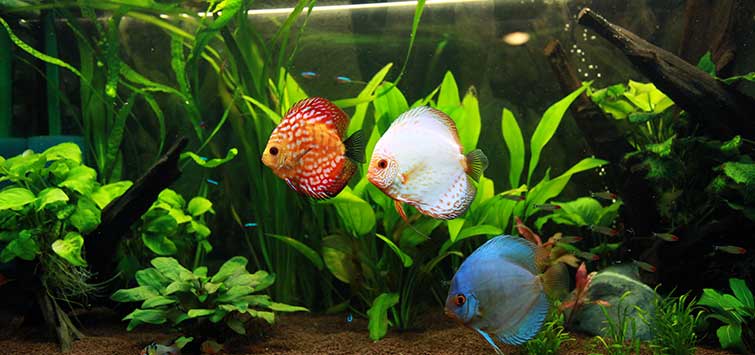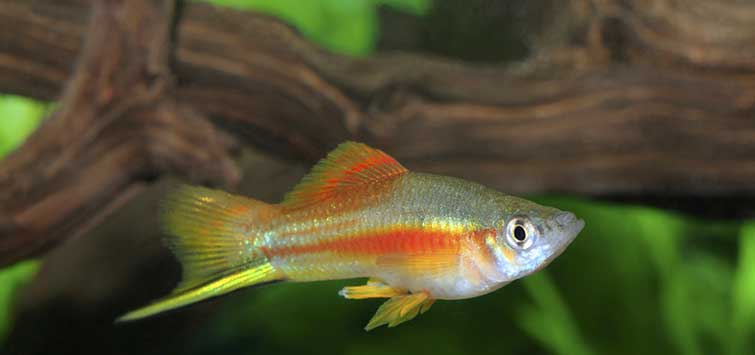Smooth Sailing: Choosing Fish for a First Aquarium
Nora Hickey, DVM & Jennifer Reynolds, MA
Choosing a fish for an aquarium is the most exciting part of fishkeeping for most hobbyists. There are so many choices, ranging from guppies with striking colors and flowing fins to a school of cute cory cats that wink at you as they sift along the aquarium bottom.
It can be tempting to bring home any fish that strikes your eye, but not all fish at your local fish store are the right choice for beginners. Striking the right balance between the size, number, and compatibility of your new fish while ensuring that you select healthy specimens and acclimate them properly are all keys to successfully stocking your first aquarium.
How Many Fish?
For the long-term success of your new aquarium, we recommend developing a stocking plan for the numbers and types of fish you’ll add so that you are choosing a fish for an aquarium that is a compatible species in the right numbers, to avoid the problems caused by overstocking and behavioral incompatibility.
First, consider how many fish you plan to introduce. Most of those you see in your local store will not have reached their adult size, so keep in mind that they will grow over time in your new aquarium and research how big each will ultimately get.
The surface area or “footprint” of the aquarium is an important consideration and is calculated by multiplying the length by the width of the tank. Essentially, it is how many square inches (or cm) are exposed to the atmosphere, and how much room the tank’s inhabitants have to swim around. Most fish use horizontal space far more effectively than vertical space. Aquariums that are shallower but have a larger footprint can house more fish than tall aquariums because there is better surface gas exchange, and the fish have more room to move around and stake out territories on the bottom.
You’ll have to figure out the maximum stocking level of your new aquarium early on and be careful to never exceed this. There aren’t any good rules for determining this. The old-fashioned “inch per gallon” rule is often cited but has too many flaws to be truly useful. Stocking levels are best determined by monitoring your waste levels, especially nitrate.
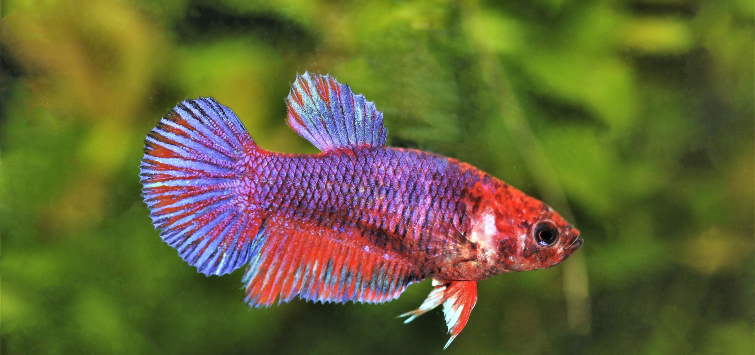
The more fish you have in your aquarium, the more frequently you will have to do maintenance like water changes, gravel siphoning, glass scrubbing, and filter cleaning. This is because each fish added requires more food and produces more waste that must be removed. Another benefit of a more conservatively stocked new aquarium is that it will be more resilient to oxygen interruptions, such as a power outage or a filter breaking, because the smaller population has a lower oxygen demand than would the population in a heavily stocked aquarium.
When developing your stocking list, you should also aim to spread your total stock through different levels of the aquarium by selecting species with different behaviors. This can alleviate competition for the same swimming areas or hiding spots and add more interest to your tank. For example, some species, like zebra danios and hatchetfish, prefer to orient to the surface, while others, like cory catfish, are bottom dwellers. Rasboras and barbs tend to loosely school in the middle of the water column, but gouramis and many cichlids often use all areas of the aquarium.
Enjoying TFH Magazine? Subscribe Today!
Selecting Appropriate Fish Species
Getting out of our fish rooms and visiting the local hobby store is an enjoyable excursion. However, it’s best to walk in with a stocking plan, lest you fall in love with a species that has incompatible water quality, food, or behavioral requirements and is better left for more experienced fishkeepers (which we hope you will become!).
Discus, for example, are show-stoppers but require husbandry experience and strict attention to water quality to thrive. Scarlet badis are small, inexpensive, and brightly colored, but they rarely accept frozen or dried food, so they typically require such live foods as baby brine shrimp, microworms, or daphnia to survive.
Other small species, such as licorice gouramis, flourish only in soft, acidic water, which is challenging to maintain for a beginner. Some commonly available species, such as the mbuna cichlids from Lake Malawi, are colorful and active but have aggressive behaviors that are challenging to properly manage.
Until you gain experience, avoid behaviorally challenging or specialist fish, and do your research for each species’ requirements to ensure that you can provide the correct water quality, diet, and tankmates. “Community tank fish” are often the best choices for new hobbyists. These are fish that get along, thrive in various water types, and will eat commonly available staple fish foods like flakes and pellets. Classic beginner community tank species we recommend include livebearers such as platies, swordtails, and guppies; small barbs, such as cherry and checkered barbs; leopard and zebra danios; bristlenose catfish; cory cats; and some gouramis.
Even when selecting among community tank fish, there are a few key considerations. Avoid significant size differences to reduce the risk of predation. Most fish are opportunistic feeders, so if a tankmate can fit in its mouth, there’s a chance it will end up there.
Avoid combining fish with long, flowing fins with those that are known to be fin-nippers. For example, avoid combining fancy guppies with tiger barbs, which are notorious fin nippers. You may also encounter this issue with other long-finned domesticated fish, such as long-finned bristlenose plecos. Bristlenose plecos tend to be stationary, so the long-finned varieties are particularly susceptible to ongoing harassment and nipping from many other fish. Long-finned fish, like fancy guppies, are best combined with smaller, peaceful community tank fish such as harlequin rasboras and cory cats.
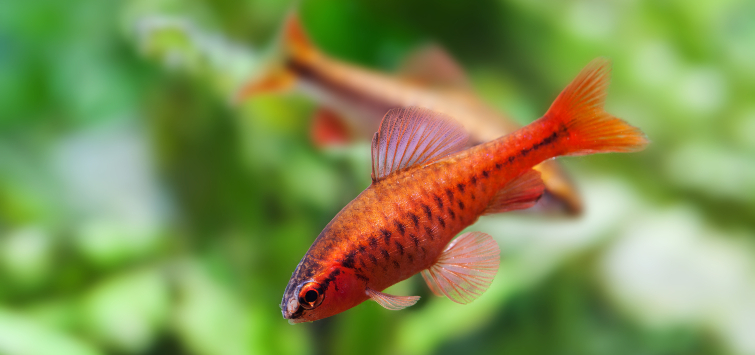
When selecting community tank fish, be sure to understand the ideal group size of the species. Many fish feel most at ease in small groups, which is how they live in nature. Great beginner species, such as harlequin rasboras, cherry barbs, and zebra danios, are best kept in groups of six or more. Cory cats also prefer to live together and will search for food and rest as a group. For group-living fish, six or more of the same species is ideal, but three to five of each of the above species is also reasonable. A lone cory cat or rasbora will be nervous, chronically stressed, and more at risk for disease.
By developing a stocking plan while you initially set up your aquarium, you can ensure that you have the correct substrate, swimming, and hiding areas for the type of fish you want to keep. For example, cory catfish kept on sharp gravel can succumb to infections resulting from abrasion to their undersides and barbels because they live on and forage in the substrate constantly. Smooth, rounded substrate—ideally fine sand—is the best choice for these catfish.
If you plan to keep mid-water schooling species, such as rasboras, or active, open-water swimmers, such as zebra danios, ensure there is ample open space for them to swim in the water column. For species that like to hide, such as bristlenose catfish, adding driftwood or special caves to hide in will help them feel secure. Other species, such as honey gouramis, appreciate aquatic plants, whether real or artificial, to interact with, swim around, and hide within when they feel nervous.
When it comes to aquascaping your aquarium, consider the fish you’ll keep and what will help them be most comfortable and able to display their natural behaviors.
Picking Out Your New Fish
The best starting point for a beginner is to check out a reputable local fish store. A good local shop can be a lifeline for new hobbyists, providing equipment, advice, and healthy livestock. If you have a local fish club, be sure to ask for their recommendations. They can also be a great source for locally bred fish.
Starting with healthy fish is critical for beginners to succeed in the hobby, as discussed in our first article in this series (“Getting Started on the Right Fin: Aquarium Startup Basics,” TFH Sep/Oct 2024). Do not settle for anything less than the best when selecting the fish for your new aquarium! Visiting several stores before making a purchase is a good step to ensure that you are bringing home the healthiest fish possible.
When you go to the store, we recommend doing a walkthrough of all the tanks before homing in on what you are interested in. Many stores have systems set up that circulate water between all the tanks, so a problem in one tank is likely a problem in others as well.
Look closely and assess the hygiene: Tanks should be clean and free of food and feces, and there should not be many dead fish present. Ask how the store handles newly arrived specimens and whether they have a separate quarantine set up for new arrivals and sick fish.
One of the best things about going to your local store is that you can view and select your fish in person. For those with unique and striking individual patterns, such as fancy guppies, going through the entire selection and then choosing the exact fish you want is a particularly satisfying process.
When evaluating potential fish to bring home, scrutinize them closely for signs of poor health, including lethargy, weak swimming, lying on the bottom or floating at the top of the tank, sunken bellies, eroded fins, wounds, and white spots. Do not bring home fish that have any of these problems. Your picks should be active and have a good appetite, clear eyes, full fins, and skin that is free of white spots or wounds.
For readers who don’t have a good local store nearby, other options include purchases from another local hobbyist or online. The downsides of these methods are that you might not get a chance to closely observe the fish you are buying prior to their arrival at your home, and there could be problems with them being sick or simply not being what you expected. But we want to mention these options because, in the age of online fish sales, everyone should be able to access healthy, high-quality fish for their home aquariums.
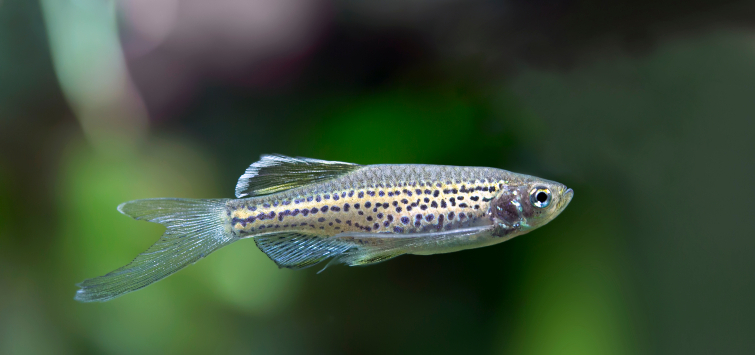
Bringing Them Home
When bringing home your very first fish for a new aquarium that doesn’t already have other fish in it, it is often easiest to put the new arrivals directly into their new home. However, as discussed in our second article in this series (“Getting Your Sea Legs: What to Consider When Stocking a First Aquarium,” TFH Nov/Dec 2024), quarantining new fish in a separate tank before introducing them to an established aquarium can save you from a lot of heartburn and heartbreak. Infectious diseases, including ick, are common in the hobby and are easier kept out than treated in your main aquarium.
Take your fish straight home from the store—do not stop for other errands on the way. This will prevent additional stress and significant water temperature changes. Once home, turn off your aquarium light and float the bag for about 15 minutes for temperature acclimation.
Then, open the bag and secure it to the side of the aquarium using clips to hold it in place. Scoop small amounts of aquarium water into the bag to allow the fish time to adjust for other parameters, such as pH. After 30 minutes, you can release your charges into their new home. You should gently net or scoop the fish from the bag and avoid releasing any bag water into the aquarium.
It is best to leave the lights off and not bother your new fish too much the first day (which can be hard to do, given all the excitement around bringing them home). This reduces stress and allows them to adjust to their new environment. It is also best to feed lightly, if at all.
Smooth Sailing
After that, it is time to enjoy your fish! The colors, activities, and surprises of the fish in your new aquarium will open up a whole new world in your home. Properly stocking your tank with the right number of healthy, appropriate fish will set you up to avoid common beginner mistakes so you can sail smoothly into fishkeeping enjoyment!

.png?h=595&iar=0&w=2781&hash=5FD5E69473BCC22199FBFA2FB71B6033)


